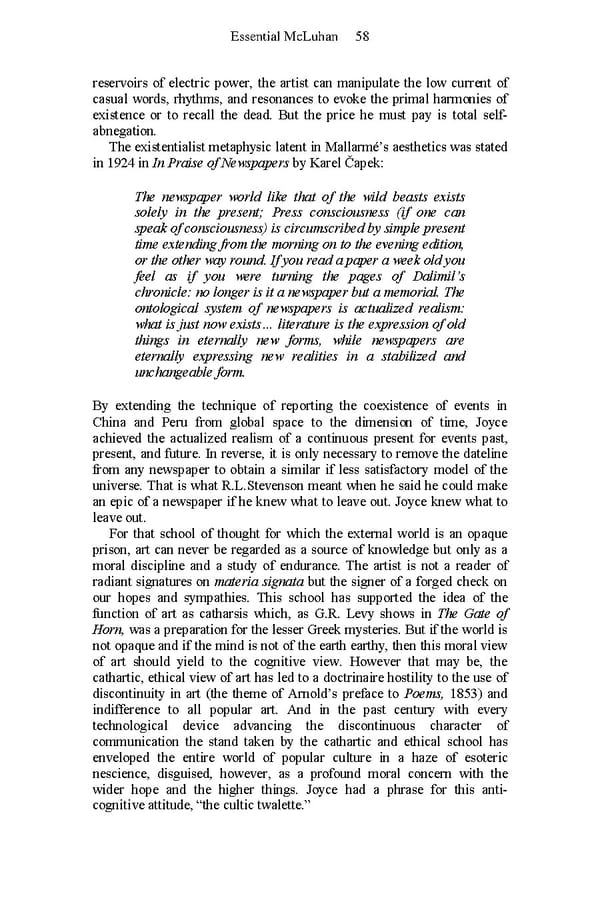Essential McLuhan 58 reservoirs of electric power, the artist can manipulate the low current of casual words, rhythms, and resonances to evoke the primal harmonies of existence or to recall the dead. But the price he must pay is total self- abnegation. The existentialist metaphysic latent in Mallarmé’s aesthetics was stated in 1924 in In Praise of Newspapers by Karel Čapek: The newspaper world like that of the wild beasts exists solely in the present; Press consciousness (if one can speak of consciousness) is circumscribed by simple present time extending from the morning on to the evening edition, or the other way round. If you read a paper a week old you feel as if you were turning the pages of Dalimil’s chronicle: no longer is it a newspaper but a memorial. The ontological system of newspapers is actualized realism: what is just now exists… literature is the expression of old things in eternally new forms, while newspapers are eternally expressing new realities in a stabilized and unchangeable form. By extending the technique of reporting the coexistence of events in China and Peru from global space to the dimension of time, Joyce achieved the actualized realism of a continuous present for events past, present, and future. In reverse, it is only necessary to remove the dateline from any newspaper to obtain a similar if less satisfactory model of the universe. That is what R.L.Stevenson meant when he said he could make an epic of a newspaper if he knew what to leave out. Joyce knew what to leave out. For that school of thought for which the external world is an opaque prison, art can never be regarded as a source of knowledge but only as a moral discipline and a study of endurance. The artist is not a reader of radiant signatures on materia signata but the signer of a forged check on our hopes and sympathies. This school has supported the idea of the function of art as catharsis which, as G.R. Levy shows in The Gate of Horn, was a preparation for the lesser Greek mysteries. But if the world is not opaque and if the mind is not of the earth earthy, then this moral view of art should yield to the cognitive view. However that may be, the cathartic, ethical view of art has led to a doctrinaire hostility to the use of discontinuity in art (the theme of Arnold’s preface to Poems, 1853) and indifference to all popular art. And in the past century with every technological device advancing the discontinuous character of communication the stand taken by the cathartic and ethical school has enveloped the entire world of popular culture in a haze of esoteric nescience, disguised, however, as a profound moral concern with the wider hope and the higher things. Joyce had a phrase for this anti- cognitive attitude, “the cultic twalette.”
 Essential McLuhan Page 64 Page 66
Essential McLuhan Page 64 Page 66